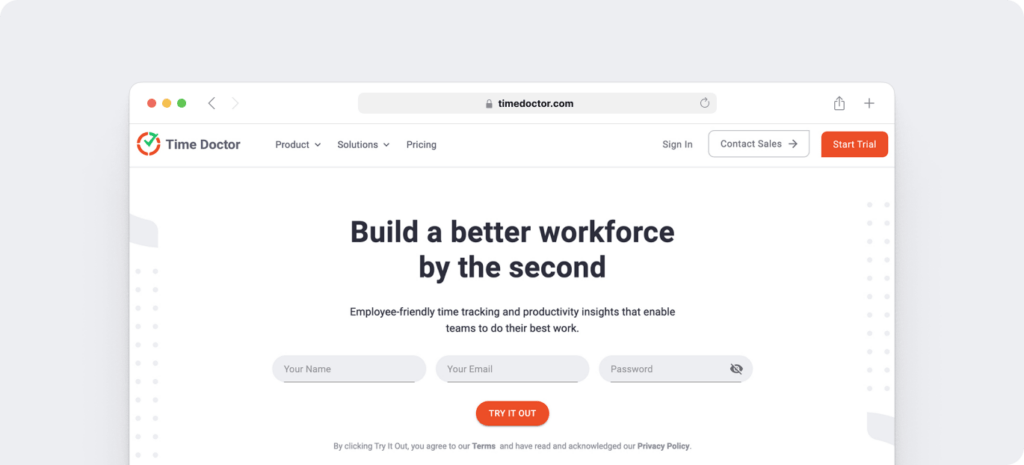Curious about employee satisfaction in hybrid workplace models?
Even before the COVID 19 pandemic and the subsequent lockdowns that changed workplace culture, organizations started recognizing the benefits of workplace flexibility.
This gave rise to the new hybrid work model — a mixed workforce of remote and in-house employees.
And while this flexible model offers various advantages for both employers and employees, some challenges can affect employee satisfaction.
In this article, we’ll explain what a hybrid workplace is, its benefits, as well as the challenges a hybrid workforce might face every day. We’ll also offer five tips to ensure employee satisfaction in hybrid teams.
This article contains:
(Click on the links below to go to a specific section)
- What is a Hybrid Workplace?
- 5 Challenges Employees Face In A Hybrid Workplace
- 5 Tips For Increasing Employee Satisfaction In Hybrid Workplace Models
- 5 Benefits Of A Hybrid Workplace for Employees
Let’s get started.
What is a hybrid workplace?
A hybrid workplace combines remote work with office work on company premises.
This working model lets employees fit work around their lives, rather than structuring it around fixed hours in a physical office.
Now there are two types of hybrid work:
- All your employees split their time between remote and in-office work.
- Some employees permanently work remotely while others work in the office full time.
You’ll need to ensure the type of hybrid model you choose works for you as well as your employees.
But why does it matter?
According to a PWC survey, 55% of employees (particularly knowledge workers such as accountants) prefer to work remotely.
However, 68% of managers think employees should be working from the office at least three days a week to maintain the organization’s culture.
A hybrid workplace model is a solution that can satisfy both employees’ need for flexibility and managers’ desire for in-house employees.
5 challenges employees face in a hybrid workplace
While a hybrid office has clear benefits for companies and employees, a few challenges may affect employee satisfaction.
Here are some issues that may arise:
1. Inability to access information
When your remote workforce doesn’t have easy access to important project information, it can negatively impact their work and job satisfaction.
How?
Let’s suppose your organization only has printed copies of policies, guidelines, and procedures which employees can’t access online.
It would put remote team members at a disadvantage because they wouldn’t be able to check up on guidelines that may be crucial for their work.
2. Lack of communication
Inefficient communication is common in hybrid workplaces as conversations will be less spontaneous and less frequent when you can’t see your employees face-to-face.
That’s why you need to ensure that your communication is clear and well planned. This way, remote employees won’t feel left out or confused about task objectives.
The problem is worse if you communicate with your onsite team daily, but you rarely converse with your remote workers. This will lead to dissatisfaction among your remote team.
Additionally, when some employees attend meetings in-person and others via a small computer screen, there’s the chance they won’t participate equally. Those joining virtually will feel like observers rather than attendees.
3. Lack of management direction
A lack of direction from managers can negatively affect employee engagement and leave employees feeling confused and unhappy.
It’s even worse when managers aren’t easily reachable.
For example, when a manager gives an employee a task and a deadline without adequate instructions and then goes on leave. Or when employers don’t provide new remote recruits with adequate onboarding and training.
You should provide clear, written instructions and training manuals to your workers, which they can access even when you aren’t available.
It’s also a good idea to regularly check in with your staff to ensure they’re on the right path. You could schedule a daily meeting at the beginning of each workday using Zoom or something similar.
If you prefer written communication, you could use an instant messaging app like Fleep or Microsoft Teams for daily check-ins.
This will let you know when employees need additional direction or even encouragement.
4. Feelings of isolation
Employees who work and live alone can experience loneliness.
Team members who shift from in-office work to remote work can also experience a deterioration in co-worker relationships due to a lack of daily interaction.
Stanford University researchers conducted a study on “The Productivity Pitfalls of Working from Home.” Respondents who were remote employees revealed that the lack of connection with other team members affected their emotional and mental health.
5. Perceived productivity
Since managers and in-office co-workers don’t physically ‘see’ the remote team working, managers can perceive them as unproductive.
When office workers think that their remote colleagues aren’t pulling their weight when it comes to the workload, it can lead to discord within the company. It can result in dissatisfaction among both your in-house and remote teams.
This perceived lack of productivity can even affect the career advancement of your remote workforce because managers are most likely to promote employees they view as productive.
5 tips for increasing employee satisfaction in hybrid workplace models
Here are a few ways to improve your teams’ hybrid working experience:
1. Rethink how you communicate
Managers not only need to communicate with remote employees clearly and often, but they also need to ensure employees can easily communicate with each other.
The best way to do this is with an online communication tool.
You’ll also need to rethink how you conduct work meetings. Having half your team physically present in a conference room and the rest attending online may result in unequal contributions.
To improve the employee experience and have more meaningful team meetings where the whole team contributes, it’s best to have everyone attend virtually, even those in the office.
Here are a few ways hybrid teams can communicate with each other:
- Instant messaging apps: For teams to stay in contact, apps like iMessage, Slack, etc., are useful. Many of these apps also allow document sharing.
- Social media: To establish your social media presence and connect with your team, apps like Workplace by Facebook and Linkedin are great options.
- Video conferencing software: You can avoid the misinterpretation of written messages by using instant video calling apps like Google Meet or similar.
2. Establish procedures and policies that benefit everyone
Nothing frustrates employees more than workplace politics and unfair treatment.
That’s why your workplace policies shouldn’t benefit just one group of employees more than the rest.
For example, a manager may favor the in-house team because they’re in the office space together and interact more. This could lead to the in-house employees getting more perks, time-off, promotions, etc.
To avoid unfair treatment that causes divisions between the in-house and remote teams, develop policies regarding attendance and timekeeping, cell phone usage, overtime, etc.,
But how will this help?
Formal written policies will help your hybrid workforce understand what the company expects from them.
It’ll also help managers treat all employees equally because standards are clearly defined and written in a policy or guide. This will result in happier and more satisfied employees.
3. Acquire the best tools and online solutions
No one likes to feel incompetent.
But that’s how remote employees could feel when you don’t adequately prepare them for work.
When employees have the right tools to do their jobs effectively, they’ll be more at ease.
You should ensure your team can access the best tools and online solutions to work productively, no matter where they’re based.
Since your in-house team will collaborate in person, you must have a way for remote employee collaboration as well.
The best solutions will help your employees communicate with managers (and each other) and access important information.
Consider using project management tools like Asana, Trello, Basecamp, etc., for collaborative tasks. These apps let employees share files and edit tasks and projects, etc., in real-time.
4. Have an accurate way to measure productivity
As you can’t see what your in-office or remote team members are doing every minute of the workday, evaluating productivity can be tricky.
When done right, hybrid work allows employees and companies to focus on what matters — performance.
However, an office environment can create ‘false positives’ that can lead to bias and favoritism.
Think about it.
Just because an employee comes in early and leaves late doesn’t make them more productive. It may ‘look’ like they’re doing more work, but their actual performance is a much better indicator of productivity.
Consider adopting a tool like Time Doctor to track time and measure employee productivity accurately.
What is Time Doctor?

Time Doctor is a time and performance management tool used by startups, SMBs like Firehouse Subs, and larger organizations like Ericsson for increased productivity across the board.
Here are some of Time Doctor’s key features:
- Flexible time tracking – manually or automatically.
- View comprehensive productivity reports to see which employees are more productive.
- See what your employees are doing on their computers with screenshots.
- Employee-friendly settings.
- Strict privacy and data security policies.
- Enable the Payroll feature to make payments to employees directly through PayPal, Gusto, Wise, etc.
- Platform compatibility with Windows, Mac, Linux, and Android systems.
- Track time from anywhere using the Android mobile app.
- Track time directly from other apps through the powerful Chrome extension.
- Integration with more than 50 apps like Jira, Trello, and Basecamp.
5. Encourage social interaction
It’s essential to look for team-building opportunities and encourage employees to interact socially.
Why?
Social connectivity among your remote and in-house teams helps them collaborate effectively on work projects.
It’ll also build company culture and help employees working from home avoid feeling isolated and lonely.
You could also consider hosting virtual happy hours, online games, or virtual company mixers where your team can meet regularly.
For more team-building ideas, check out our list of virtual team-building activities.
5 benefits of a hybrid workplace for employees
Once you address the challenges, there are numerous advantages for both employers and employees.
Here are a few ways employees can benefit from a hybrid workplace:
1. More leisure time
Survey results from Manpower Solutions revealed that 40% of employees believe workplace flexibility is a non-negotiable requirement.
To maintain flexibility, hybrid workers can divide their workweek between home and the office. For example, they may work four days remotely and go into the office once a week.
By saving time traveling to and from work, employees have more leisure time with family and friends. It can also improve personal relationships.
Employees in a flexible work environment are happier because remote working can lower stress and provide more time for hobbies and interests.
2. Lower expenses
A remote employee who only comes into the office occasionally can save money by not commuting daily.
This way, employees can live wherever they choose. They could even relocate to more affordable accommodation further away from the office.
3. Greater travel opportunities
In a post-COVID scenario, the hybrid workforce model offers employees more travel opportunities. The idea of the ‘digital nomad’ has become popular among remote employees.
The flexibility of hybrid work arrangements means employees don’t have to clock in and out at the same time every day, and they can work from anywhere with a computer and WiFi.
This freedom allows them to travel to different countries whenever they want.
4. Work when and where they’re most productive
In a hybrid working model, employees have the freedom to work when and where it suits them. It allows them to work when they are most productive in the spaces they find conducive to work.
Being able to create a comfortable home office is an excellent benefit.
For example, if a hybrid worker wants a more ergonomic chair or has health issues that require special equipment, they can set up a more comfortable workspace.
5. Impact on health and safety
In addition to the work life balance that your employees can achieve, hybrid work positively impacts employees’ physical well-being.
This is because employees can avoid traveling on crowded public transport or working in a crowded office. Social distancing can significantly reduce their risk of Coronavirus infection.
Employees also have more time for physical activity, which can help improve their health and wellness.
Those employees recovering from an injury, surgery, or illness such as COVID-19 can do so while working comfortably at home.
Wrapping up
Hybrid workforces are part of the new normal, even post-Covid.
However, you’ll need to be careful when setting up your hybrid workplace. You should prioritize your entire team’s interests and not just those of the company.
Use the techniques we’ve covered here, and you’ll be able to improve employee satisfaction and productivity in a hybrid workplace.

Vaishali Badgujar is a Content and SEO specialist at Time Doctor, an employee-friendly time-tracking system that boosts productivity.


